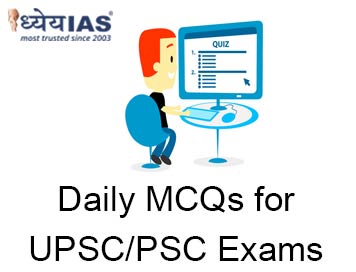Home > Daily-mcqs
Daily-mcqs 24 Apr 2025

Q1:
What is the primary purpose of the Liquidity Coverage Ratio (LCR)?
A: Ensure banks maintain solvency under long-term stress
B: Regulate interest rates across commercial banks
C: Ensure availability of high-quality liquid assets to survive a short-term crisis
D: Prevent digital fraud in internet banking transactions
Answer: C
Explanation:
The Liquidity Coverage Ratio (LCR) is a regulatory standard introduced post the 2008 financial crisis by the Basel Committee to ensure that banks maintain an adequate stock of High-Quality Liquid Assets (HQLA) that can be easily converted to cash to meet 30-day stress obligations. It does not target solvency (a), interest rates (b), or cyber fraud (d). The revised norms aim to improve LCR compliance in the digital age, considering the rapid withdrawal potential of internet and mobile banking. Thus, (c) is the correct purpose.
Q2:
With reference to GPS spoofing, consider the following statements: How many of the above statements are correct?
A: Only one
B: Only two
C: Only three
D: All four
Answer: C
Explanation:
Statements 1, 3, and 4 are correct. GPS spoofing sends fake satellite signals to mislead systems and has been used in the Russia-Ukraine war. It can affect crucial aviation systems. However, it is different from jamming, which blocks signals—so Statement 2 is incorrect.
Q3:
The “Soft Release Protocol” in wildlife conservation is primarily associated with which of the following objectives?
A: Increasing genetic diversity in zoo-bred species
B: Acclimatizing captive-bred animals before reintroducing them into the wild
C: Preventing the spread of zoonotic diseases in animal populations
D: Monitoring predator-prey dynamics in protected reserves
Answer: B
Explanation:
The soft release protocol is a key method in wildlife conservation, especially for species bred in captivity and being prepared for reintroduction into their natural habitat. Unlike hard release, where animals are released directly into the wild, soft release involves a transitional phase in controlled enclosures (pre-release aviaries). This allows the animals—such as vultures in the 2025 Pinjore-to-Maharashtra transfer—to adapt to real-world conditions like climate, terrain, and food availability. It enhances survival rates, reduces stress, and improves natural behaviors. It is especially crucial for birds, big cats, and other sensitive species, aligning with long-term conservation and breeding strategies.
Q4:
Consider the following statements with reference to a hydrogen-based explosive device using magnesium hydride: 1. The device uses magnesium hydride to store hydrogen at high densities for controlled energy applications. 2. Its explosion pressure is about 40% higher than that of TNT. 3. It produces a long-lasting thermal burn, increasing its destructive potential. 4. Magnesium hydride is also being explored for clean energy uses in military technology such as drones and submarines. How many of the above statements are correct?
A: Only one
B: Only two
C: Only three
D: All four
Answer: C
Explanation:
Statements 1, 3 and 4 are correct. Magnesium hydride is able to store hydrogen at high densities, making it useful in both explosive and energy applications. This hydrogen-based device produces a long-lasting thermal burn, which increases its destructive power. Additionally, magnesium hydride is being explored for use as a clean energy source in military green technology such as drones and submarines. However, statement 2 is incorrect — the blast pressure of this device is only about 40% of TNT, meaning it is less powerful in terms of the intensity of the shock. So only three out of four statements are correct.
Q5:
Consider the following statements regarding the India-Saudi Arabia strategic partnership:
Which of the statements above is/are correct?
A: 1 and 2 only
B: 2 and 3 only
C: 1, 2, and 3
D: 1 only
Answer: A
Explanation:
India is Saudi Arabia’s second-largest trade partner, and Saudi Arabia committed USD 100 billion in investments. However, Indian investments in Saudi Arabia are USD 3 billion, not USD 10 billion.